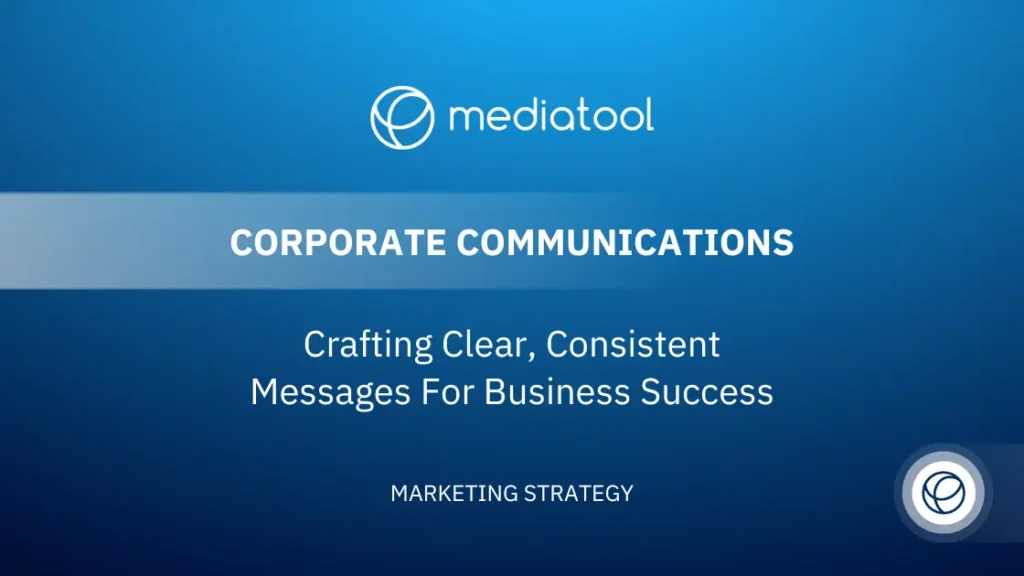When companies try to juggle their internal and external messaging, corporate communications often hit a roadblock. This challenge leads to confusion, a weakened brand image, and missed chances to connect with important audiences.
The struggle intensifies as mixed signals and unclear messages make it harder for companies to stay aligned with their stakeholders, risking their reputation and financial health. Adopting a solid corporate communications strategy is the key to navigating this maze.
By focusing on clear, consistent messaging that mirrors the company’s objectives and values, organizations can improve their relationships with stakeholders, boost their image, and secure a stronger position in the marketplace.
What is Corporate Communications?
Corporate communications is the heartbeat of any organization. It involves managing and orchestrating all internal and external communication to create favorable points of view among stakeholders on which the company depends.
This broad field encompasses everything from internal memos to press releases, social media posts, and beyond. It’s about ensuring the company’s messaging is consistent, cohesive, and reflects the brand’s values, mission, and vision.
What are the Functions of Corporate Communications?
Managing Internal Communications
At the heart of corporate communications is the oversight of internal communications. This area is about keeping employees at all levels in the loop, engaged, and aligned with the company’s objectives.
Effective internal communication promotes transparency, enhances employee engagement, and improves teamwork. Every piece of communication reinforces the corporate identity, from internal blogs to team meetings, playing a key role in building a positive company image internally.
Crafting External Communications
External communications are essential for shaping the company’s public image and messaging to the outside world, including customers, investors, and the media.
This function encompasses various activities, from issuing press releases, organizing media events, managing social media posts, and producing marketing materials.
The aim is to ensure consistent brand messaging across all channels, protecting the brand’s reputation and maintaining a positive stance with external audiences.
Conducting Media and Public Relations
The corporate communications team leads media relations and public relations efforts. These experts manage the organization’s relationship with the press and the public, organizing news conferences and virtual press conferences and responding to press inquiries.
Their skill in creating press materials and interacting with journalists is key for promoting company news and managing public perception of its strategies and actions.
Navigating Crisis Communications
Crisis communication is an essential function within corporate communications to safeguard and manage the company’s reputation during challenging times.
Corporate communications experts develop crisis communication strategies to quickly and effectively address potential threats. They ensure that communication in a crisis is clear, accurate, and consistent across all platforms, helping to reduce any negative effects on the company’s image.
Fostering Investor Relations
Investor relations is a significant part of external communications, focusing on managing the company’s interactions with shareholders, investors, and financial analysts.
This function involves disseminating company news, financial reports, and strategic directions to the investment community to maintain transparency and trust. Communicating effectively with this group supports the organization’s financial health and prospects for growth.
Overseeing Customer Communications
Customer communications are key to building and sustaining relationships with the company’s customer base. This involves addressing customer inquiries and feedback and proactively communicating about products, services, and company updates.
Ensuring that customer communication is consistent and reflects the company’s brand identity is important for cultivating a loyal customer base and a positive reputation in the market.
Through these diverse and dynamic functions, corporate communications professionals play an indispensable role in managing internal and external communications.
Their work is essential in maintaining a coherent corporate identity, engaging with internal and external stakeholders, and ultimately contributing to the business’s success.
Important Points to Consider about Corporate Communications

Diving into corporate communications reveals its broad impact on internal and external stakeholders. This domain extends beyond merely sharing information; it’s centered on cultivating relationships, nurturing trust, and enhancing a positive reputation.
A well-executed corporate communication strategy ensures alignment among all stakeholders with the company’s objectives and core values. Especially during crises, adeptly developed crisis communication strategies are instrumental in reducing harm and preserving the organization’s trustworthiness.
Aligning with Company Goals and Values
Ensuring that every communication reflects the company’s goals and values is fundamental. This alignment is not only essential for internal stakeholders but also for external audiences.
It’s the backbone of effective organizational communication, reinforcing the company’s mission through every message conveyed.
Crisis Communication Strategies
The ability to manage crises through strategic communication is indispensable. Such strategies prevent potential damage and help maintain the company’s standing.
Crafting these plans requires a deep understanding of both the situation and the stakeholders involved, underscoring the importance of a proactive approach in corporate communications.
Understanding the Target Audience
A thorough grasp of the target audience is critical. This understanding influences how the corporate communications department shapes its messages, ensuring they resonate well with internal and external audiences.
Tailoring messages to meet the expectations and needs of these audiences is a skill that enhances communication effectiveness.
Maintaining Brand Identity
Staying true to the brand’s identity in all forms of communication is key. Whether it’s through marketing communications, employee communication, or general customer communications, consistency in the brand’s voice and message fortifies the company’s image and aids in building a lasting positive reputation.
Proactive Communication
Being proactive rather than reactive in communication efforts marks the difference between leading and lagging in corporate communication.
This proactive stance is vital in areas ranging from marketing communication and management communication to employee handbooks and disseminating the company’s product information. It involves anticipating the needs and questions of internal and external stakeholders and addressing them before they escalate.
Leveraging Technical Skills and Tools
The effectiveness of a corporate communication plan often hinges on the technical skills of the communications team and the tools they employ.
From managing internal messaging systems to deploying various marketing materials, the technical prowess within the corporate communications department plays a significant role in how efficiently and effectively the organization communicates.
Role of Leadership Communication
Leadership communication stands as a pillar within the corporate communication functions. It’s about guiding the company through clear, decisive messaging from the top down.
Leaders play a crucial role in setting the tone for transparency and engagement, directly influencing the organization’s culture and stakeholder perception.
Skills Required for Corporate Communications Professionals
Corporate communications professionals wield a diverse skill set to navigate the intricate landscape of their field effectively. These skills encompass:
- Exceptional writing and verbal communication: Being adept at crafting clear, compelling messages is essential.
- Critical thinking and problem-solving: The capacity to analyze situations, foresee challenges, and develop solutions is important.
- Strategic planning abilities: Professionals need to be proficient in devising long-term strategies for corporate communication departments, aligning them with the company’s broader objectives.
A thorough understanding of digital marketing and social media management is necessary, as these channels are key for reaching external and internal audiences. Knowledge in public relations, including conducting press conferences and engaging in media communication, is also required.
Other indispensable skills include:
- Emotional intelligence: Recognizing and appropriately responding to the emotions of others helps build strong connections.
- Adaptability: The ability to modify strategies based on evolving circumstances or feedback is essential.
- Awareness of internal and external sentiments: Listening to and understanding the perspectives of different audiences to respond effectively is key.
Additionally, corporate communications involves managing interactions across a variety of platforms and audiences. This includes implementing marketing strategies that resonate with target groups and collaborating across departments to ensure consistent messaging.
Public relations specialists are integral to this effort, utilizing their skills to improve the company’s image and facilitate effective communication with the media.
The effectiveness of most communications teams relies on these skills, enabling them to tackle the multifaceted challenges of corporate communications confidently.
Develop a Corporate Communications Strategy and Roadmap

Define Clear Goals and Objectives
The first step in creating a robust corporate communications strategy is to outline clear goals and objectives that mirror the company’s overall mission. This foundational step ensures that all subsequent actions are aligned with the company’s direction and purpose.
Whether the aim is to boost brand identity, manage the company’s reputation during a crisis, or enhance employee engagement, setting precise goals is critical.
Identify the Target Audience
Understanding who you’re communicating with is crucial. The target audience could be internal employees, external audiences such as media and customers, or internal and external stakeholders.
Each group requires tailored messaging that addresses their specific needs and interests. Recognizing these diverse audiences enables corporate communications professionals to craft strategies that resonate on multiple levels.
Choose the Right Channels
Next, it’s essential to determine the most effective channels for reaching your target audience. This might include traditional channels like press releases and media events, as well as digital platforms such as social media and internal blogs.
The channel choice plays a significant role in the success of the communication effort, as it impacts how well the message is received and understood by internal and external audiences.
Craft Resonating Messages
Developing messages that resonate with each segment of your audience is essential. This involves not only conveying company news and updates but also ensuring that the messaging effectively supports the corporate identity and brand’s reputation.
Consistent brand messaging across all forms of communication helps in building a positive image and reinforces the company’s values to both internal and external stakeholders.
Measure Success and Adapt
Finally, establishing metrics to measure the effectiveness of the communications strategy is imperative. This could involve tracking engagement rates, press coverage, or changes in employee sentiment.
By analyzing these metrics, communications teams can identify areas for improvement and adjust their strategy accordingly. This ongoing process helps refine the approach to corporate communication, ensuring it remains dynamic and responsive to the organization’s and its audiences’ needs.
Incorporating these steps into the development of a corporate communications plan ensures a comprehensive approach that supports business success.
Through effective management of internal and external communications, organizations can foster a strong corporate reputation, maintain consistent messaging, and engage meaningfully with all stakeholders.
Wrap Up
Corporate communications link a company with its audience, focusing on clear messages that align with the company’s goals and foster positive reception. This role includes everything from internal updates to public engagements via social media and press releases.
Professionals handle various tasks such as strategic messaging, crisis management, customer engagement, and investor relations. Essential skills include digital marketing, public relations, and the ability to adapt to changing situations.
Developing a corporate communications strategy involves understanding the company’s objectives, knowing the audience, choosing the right communication channels, and ensuring messages reinforce the brand. It requires proactive planning, impact measurement, and readiness to adjust strategies based on feedback.
Corporate communications is vital for maintaining a positive company image and building strong relationships, directly contributing to business success.





